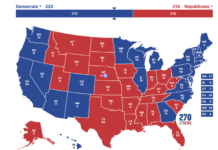JUNE 29, 2023

FREMONT, CA- JULY 11: Protesters attend a pro Affirmative Action rally against Proposition 16 at Fremont City Hall in Fremont, Calif., on Saturday, July 11, 2020. After speeches, attendees got in their vehicles to protest in a car caravan around Fremont. American voters will decide if Prop 209 is repeal by Prop 16 on the November ballots.
The Supreme Court’s landmark decision on Thursday to gut affirmative action has made it unlawful for colleges to take race into consideration as a specific factor in admissions.
The ruling means that admissions programs like those at the two universities at the center of the case, Harvard University and the University of North Carolina, are no longer permitted.
Here are some other key effects of the ruling.
Majority says race can still be a part of admissions applications, minority unconvinced
While the decision will impact admissions policies that have historically benefited Black and Latino students, the ruling still allows colleges and universities to consider an applicant’s discussion of how race has affected their life as long as it is “concretely tied” to a “quality of character or unique ability” that the applicant can bring to the school.
Chief Justice John Roberts, in the majority opinion, noted that applicants could share in essays also how their heritage or culture motivated them to take on a leadership role, for instance.
“In other words, the student must be treated based on his or her experiences as an individual—not on the basis of race,” the opinion stated.
Dissenting Democratic-appointed justices objected, insisting that the ruling would make it practically impossible for colleges and universities to take race into account in admissions.
Justice Sonia Sotomayor wrote that the court was “merely” imposing its “preferred college application format” on the country by “taking on the role of college administrators to decide what is better for society.”
“Because the Court cannot escape the inevitable truth that race matters in students’ lives, it announces a false promise to save face and appear attuned to reality,” she wrote. “No one is fooled.”
What the ruling has not changed
While colleges and universities will no longer be able to consider race as the sole factor, Sotomayor noted in her dissent that the ruling still allows colleges and universities to consider other factors to increase diversity on campus.
Colleges can consider students who speak multiple languages or could be the first in their family to attend college, Sotomayor wrote.
“Those factors are not ‘interchangeable’ with race,” she wrote.
The Biden administration also announced several plans Thursday to help colleges continue their efforts to recruit diverse student bodies in light of the decision. Those steps include releasing a report on strategies for increasing diversity and educational opportunity and providing schools with guidance on what is and isn’t allowed, among other things.
The impact will vary state-by-state, school-by-school
Not all higher education institutions will be affected by the ruling. The decision allows US military service academies to continue to take race into consideration as a factor in admissions.
Steve Vladeck, CNN Supreme Court analyst and professor at the University of Texas School of Law, said that the impact could also vary depending on where schools are located.
In states that continue to permit colleges and universities to take race into account, “we’ll surely see efforts to encourage the kinds of uses the majority does not expressly disavow — whether in diversity statements or elsewhere,” he said.
Courtesy/Source: CNN































































































